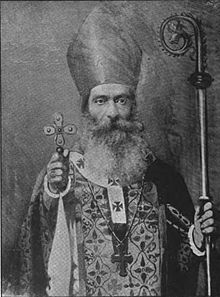
Back إغناطيوس ميخائيل الثالث جروة Arabic اجناطيوس مايكل التالت الجاروه ARZ Ignatius Michael III. Jarweh German Ignace Michel III Jarweh French Ignazio Michele III Jarweh Italian Ignacy Michał III Dżarweh Polish Игнатий Михаил III Russian
Mar Ignatius Michael III Jarweh | |
|---|---|
| Patriarch of Antioch | |
 | |
| Church | Syriac Catholic Church |
| See | Patriarch of Antioch |
| Installed | January 22, 1783 |
| Term ended | September 4, 1800 |
| Predecessor | Ignatius George IV |
| Successor | Ignatius Michael IV Daher |
| Personal details | |
| Born | Dionysius Michael Jarweh ibn Ni'matallah January 3, 1731 Aleppo, Syria |
| Died | 4 September 1800 (aged 69) Al-Charfet monastery, Mount Lebanon |
| Residence | Aleppo, and then Charfet |
Mar Ignatius Michael III Jarweh ibn Ni'matallah (or Javré, Jaroueh, Garweh, Djarweh, Giarvé, 1731–1800) was the 111th Patriarch of Antioch and Patriarch of the Syriac Catholic Church from 1783 to 1800.
In 1757 Michael Jarweh converted to Catholicism and took with him a large number of his congregants.[1]
On July 21, 1781, his Syriac Orthodox predecessor Patriarch George IV died, and the bishops (five were present), clergy and laity met in the Dayr al-Zafaran monastery and elected Ignatius Michael III Jarweh as Patriarch; he accepted only after the reading and the approval of a Catholic declaration of faith in the Church of the Forty Martyrs, Mardin. He was enthroned in Mor Hananyo Monastery on 22 January 1783 and took the traditional name of Ignatius III. His election was confirmed by the Pope on September 14, 1783, and he received the Pallium, the sign of patriarchal authority, on December 15 of the same year. The Syrian Catholic Church once again had a patriarch.
Two Syriac bishops opposed his election: two days after Michael's enthronement they took the money of the monastery and paid a group of Kurds who attacked Mardin,[2]: 390 making fatalities: Michael survived, but lost many days. In the meantime one of these two Syriac Orthodox bishops, Mar Matta ben Abdel-Ahad Saalab, bishop of Mosul, consecrated to bishop four of his monks[2]: 391 in order to hold a second election[1] and thus he was elected Syriac Orthodox patriarch. This party arrived at Istanbul before Michael's envoy, and received the formal approval of the Ottoman authorities, and could thus continue a parallel Syriac Orthodox tradition.
- ^ a b Frazee, Charles A. (2006). Catholics and Sultans: The Church and the Ottoman Empire 1453–1923. Cambridge University Press. pp. 207–209. ISBN 978-0-521-02700-7. Retrieved February 22, 2009.
- ^ a b Cite error: The named reference
Jarwwas invoked but never defined (see the help page).